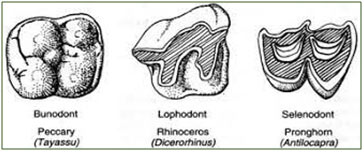Introduction
Cheek teeth are premolars and molars are ridged multiple-rooted teeth. They lie just behind the canine and are generally used for grinding food. Structurally premolars and molars are quite similar.
The only difference is that premolars appear in milk as well as permanent sets of teeth while molars only appear in permanent sets. Cheek teeth are specialized for shearing flesh in carnivores and for grinding in herbivores.
Cheek Teeth pattern in mammals

Mammals exhibit a number of patterns due to differences in the shape of the crown.
1. Secodont Teeth
In these types of teeth, the crown is laterally compressed and the sharp edges of cusps of the upper and lower set fit between one another to produce a shearing effect when jaws are closed.
Secodont teeth are found in carnivores. The first lower molar and last upper premolar are called carnassial teeth.
2. Selenodont Teeth
In ungulates such as horses, rhinoceros, deer, cattle, etc. the crown is broad and enamel is disposed of in vertical crescent-shaped columns separated by dentine. The softer dentine is worn down so that teeth provide sharp crescentic rasping ridges. Such cheek teeth are called selenodont.
3. Lophodont Teeth
These are an exaggerated condition of selenodont teeth and have enamel dentine. The enamel dentine is intricately folded and disposed of as transverse ridges or lophs on enormous dental plateaus.
The largest elephants have lophodont teeth which are about a foot or more in length and one-third of a foot in width.
4. Bunodont Teeth
These are the teeth that have low rounded mound-like cusps which are entirely covered with enamel. They wear down evenly.
Bunodont teeth are present in man, some rodents such as a white-footed mouse, some hogs, some primitive ruminants, and rhinoceros.
5. Brachydont Teeth
Some rodents possess cheek teeth with a low crown and long roots. These types of teeth are called brachydont teeth. For example, the squirrel has brachydont teeth.
6. Hypsodont Teeth
Some rodents have cheek teeth with a high crown and short roots. Such as wood rats have hypsodont teeth. Other mammals that possess hypsodont teeth are horses and certain cattle. Tusks are also the hypsodont teeth.

7. Triconodont and Trituberculate Secodont Teeth
- Triconodont Teeth: A tooth with three cusps or cones.
Early placental mammals had Triconodont cheek teeth which had three cone-like structures aligned in a straight line.
- Tritubercular teeth: A haplodont tooth with two cones, one in front and one behind the main one.
In later mammals, cones were arranged in a triangle forming tritubercular secodont teeth. Then crests connecting the tubercles were formed which led to the evolution of selenodont teeth and lophodont teeth.
